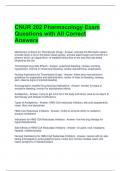CNUR 202 Pharmacology Exam
Questions with All Correct
Answers
Mechanism of Action for Thrombolytic Drugs - Answer- activiate the fibrinolytic system
to break down a clot in the blood vessel quickly, activate plasminogen and convert it to
plasmin which can digest fibrin, re-establish blood flow to the area that was being
blocked by the clot
Thrombolytic Dug Side Effects - Answer- superficial bleeding, nausea, vomiting,
hypotension, internal or intracranial bleeding, cardiac dysrhythmias, anaphylaxis
Nursing Implications for Thrombolytic Drugs - Answer- follow strict manufacturer's
guidelines for preparation and administration, minitor IV sites for bleeding, redness,
pain, observe signs of internal bleeding
Anticoagulation modifier Drug Nursing Implications - Answer- monitor for signs of
excessive bleeding, monitor for side/adverse effects
Antilipemics - Answer- trying to get rid of fat in the body and blood, used as an adjunt to
diet therapy and lifestyle modifications
Types of Antilipemics - Answer- HMG-CoA reductase inhibitors, bile acid sequestrants,
niasin, fibric and derivatives
HMG-CoA Reductase Inhibitors - Answer- inhibit an enzyme which is needed to
produce cholesterol
Indications for HMG-CoA Reductase Inhibitors - Answer- first-line drug therapy for
hypercholesteremia
Side Effects of HMG-CoA Reductase Inhibitors - Answer- GI upset, rash, headache,
hepatits, rhabdomyolysis
Nursing Implications for HMG-CoA Reductase Inhibitors - Answer- caution with pt, also
taking anticoagulant, avoid grapefruit juice, moitor liver function studies, teach and
report symptoms of rhabdomyolysis
,Bile Acid Sequestrants - Answer- creates an insoluble bile acid-resin (drug) complex
that is excreated by the bile
Examples of Bile Acid Sequestrants - Answer- cholestyramine and colestipol
Side Effects of Bile Acid Sequestrants - Answer- constipation, heartburn, nausea,
belching, bloating
Nursing Implications for Bile Acid Sequestrants - Answer- come in powder form and
must be mixed thoroughly, do not give to a pt with PKU, notify HCP if unusual bleeding
ot blac, tarry stools occur
Nicotinic Acid - Answer- Lipid-lowering properties require much higher doses than when
used as a vitamin, inhibits lipolysis in adipose tissue
Interactions for Nicotinic Acid - Answer- should not be given with statins d/t increased
risk of myopathy
Fibric Acid Derivatives - Answer- beleived to work by activating lipase, which breaks
down cholesterol; suppress release of free fatty acid from the adipose tissue, inhibit
sythesis of triglycerides in the liver, and increase the secreation of cholesterol in the bile
Side Effects of Fibric Acid Derivatives - Answer- abd discomfort, blurred vision,
increased risk of gallstones, muslce pain
Nursing Implications of Antilipemics - Answer- obtain health and medicatio history,
baseline liver function studies, high fibre diet, instruct pts to report peristant GI upset,
constipation, abnormal or unusual bleeding, yellow discolouration of the skin
Empiric Therapy - Answer- treatment of an infection before specific culture information
has been reported or obtained
Definitive Therapy - Answer- antibiotic therapy tailored to treat organism identified with
cultures
Prophylactic Therapy - Answer- treatment with antibiotics to prevent an infection, as in
intra-abd surgery or after trauma
Therapeutic Response of Antibiotic Therapy - Answer- decreased in specific signs and
symptoms of infection are noted
Subtherapeutic Response of Antibiotic Therapy - Answer- signs and symptoms of
infection do not improve
Most Common Severe Reactions of Antibiotic Therapy - Answer- difficulty breathing,
significant rash, hives, or therskin reactiion, severe GI intolerance
, Bactericidal Antibiotic - Answer- one that kills bacteria
Bacteriostatic Antibiotic - Answer- one that inhibits growth of susceptible bacteria rather
than killing them immediately; will eventually lead to bacterial death
Sulfonamides - Answer- inhibit the growth of bacteria, first group of antibiotics, prevent
synthesis of folic acid required for synthesis of purines and nucleic acid
Indications for Sulfonamides - Answer- treatment of UTIs, prophylaxis and treatment of
pneumocystis jirovecii pnemonia, treatment of upper respiratory tract infections
Adverse Effects of Sulfonamides - Answer- hemolytic and aplastic anemia,
agranulocytosis, thrombocytopenia, photosensitivity, SJS, epidermal necrolysis, nausea
and vomiting, diarrhea, pancreatitis, hepatotoxicity, convulsions, crystalluria, headache,
neuritis, urticaria, cough
Beta-lactam Antibiotics - Answer- penicillins, caphalosporins, carbapenems,
monobactams
Types of Penicillan's - Answer- natural: penicilling G, penicillin V potassium,
penicillinase-resistant drugs: cloxacillin, aminopenicillins: amoxicillin, ampicillin,
extended-spectrum drugs: piperacillin, ticarcillin
Mechanism of Action for Penicillin's - Answer- enters the bacteria via the wall, they bind
to penicillin-binding protien, once bound the normal call wall synthesis is disrupted,
bacteria cells then die from cell lysis, penicillins do not kill other cells in the body
Contradictions of Penicillin's - Answer- kwown medicaiton allergy, not all names end in
"cillin", many medication errors have occured when a penicillin drug by its trade name is
given to a pt. with a penicillin allergy
Penicillin's with Beta-Lactamase - Answer- some bacteria prodeuce enzymes capable of
destroying penicillins, these chemicals bind with beta-lactamase and prevent the
enzyme from breaking down the penicillin, thus making the drug more effective
Indications for Penicillin's - Answer- gram-positive bacteria, strepococcus species,
enterococcus species, staphylococcus species
Adverse Effects of Penicillins - Answer- allergic reactions, diarrhea, abd pain, nausea,
vomiting
Pseudomembranous Colitis - Answer- a common adverse effect of most antibiotics,
caused by exotoxins of C. difficile which damage the mucose and produce a
pseudomembrane composed of inflammatory excude





